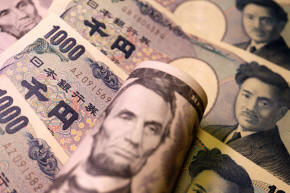Dollar set for weekly fall as markets reassess Fed rate
hike bets
 Send a link to a friend
Send a link to a friend
 [August 12, 2022] By
Elizabeth Howcroft [August 12, 2022] By
Elizabeth Howcroft
LONDON (Reuters) -The dollar rose on Friday but
was still set for a weekly decline as traders looked for signs of U.S.
inflation peaking.
U.S. inflation figures on Wednesday and Thursday were lower than
expected, boosting riskier assets such as equities and weakening the
dollar, as markets interpreted the data as indicating the Fed could be
less aggressive in rate hikes.
But Fed officials made clear they would continue to tighten monetary
policy. San Francisco Federal Reserve Bank President Mary Daly said on
Thursday she was open to the possibility of another 75 basis point (bp)
hike in September to fight too-high inflation.
At 1047 GMT, the dollar index was up 0.4% on the day at 105.520,
changing course after four days of losses that have put it on track for
a weekly decline of 1%.
The yen lost out to the dollar's strength, with the U.S. unit up 0.5%
against the Japanese currency at 133.62.

Traders were pricing in around a 36.5% chance of a 75 bps Fed rate hike
in September and a 63.5% chance of 50 bps.
"We think it will take far more evidence of slowing core inflation to
temper Fed tightening," Paul Mackel, global head of FX research at HSBC,
said in a note to clients.
"Inflation is also a global problem not just a U.S. one, and so global
growth and inflation dynamics will also drive the USD," Mackel said.
"The likes of the ECB (European Central Bank) and the BoE (Bank of
England) may still find it hard to match market pricing for rate hikes,
creating downside pressures for EUR and GBP."
Kit Juckes, head of FX strategy at Societe Generale, said dollar trading
was likely to remain "choppy".
“It’s not going to be going significantly weaker in a straight line
because there’s still a danger than the market has to reprice terminal
Fed funds higher, given there’s still plenty of inflation,” Juckes said.
[to top of second column] |

Japanese
yen and U.S. dollar banknotes are seen in this illustration picture
taken June 15, 2022. REUTERS/Florence Lo/Illustration

GDP CONTRACTION
The British pound was down 0.8% at $1.212 versus the strong dollar. UK GDP
contracted by less than feared in June, even though an extra public holiday had
been expected to cause a big drag.
The euro was down 0.3% at $1.0291. French inflation was up 6.8% year-on-year in
July, while for Spain the figure was 10.8%, the highest since 1984, data showed.
The euro has been weighed down by Europe's struggles with the war in Ukraine,
the hunt for non-Russian energy sources, and a hit to the German economy from
scant rainfall. Low water levels on the Rhine, Germany's commercial artery, have
disrupted shipping and pushed freight costs up more than five-fold.
Commerzbank said in a note to clients it had revised its euro-dollar forecast
lower, as it expects a euro-area recession as a base scenario, having previously
been a "risk scenario". Commerzbank expects the euro to fall to $0.98 in
December and to not recover until later in 2023.
Inflation in Sweden eased to 8% year-on-year in July, which ING said may lessen
expectations for a massive Riksbank rate hike in September.
"After a good run in July, we doubt the Swedish krona pushes on too much further
against the euro," ING's Turner said.
The New Zealand dollar was lifted by expectations of a Reserve Bank of New
Zealand rate rise next week.
(Reporting by Elizabeth Howcroft; Editing by Mark Potter and David Holmes)
[© 2022 Thomson Reuters. All rights
reserved.]This material may not be published,
broadcast, rewritten or redistributed.
Thompson Reuters is solely responsible for this content.
 |